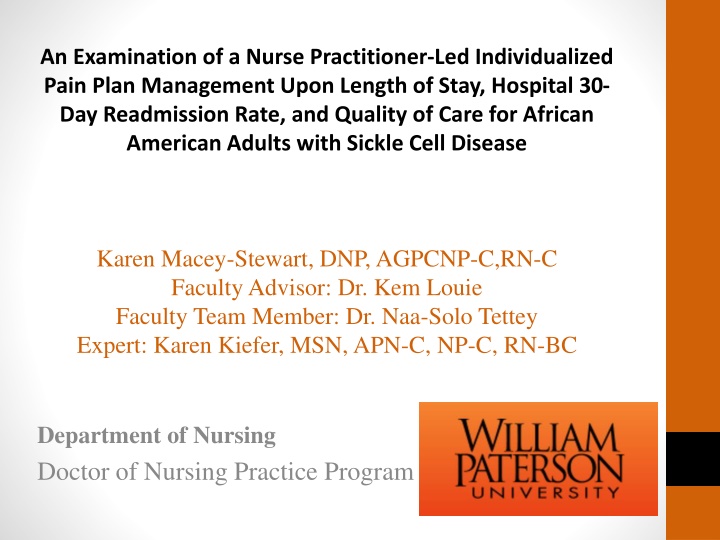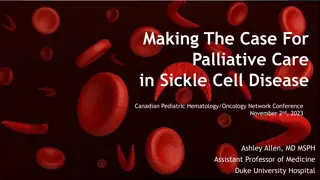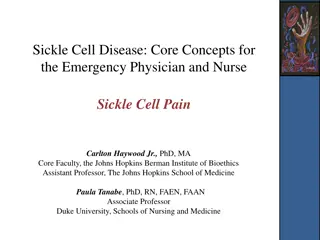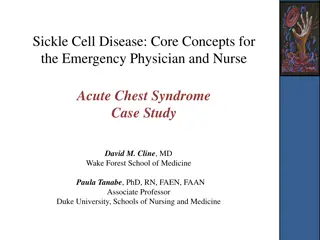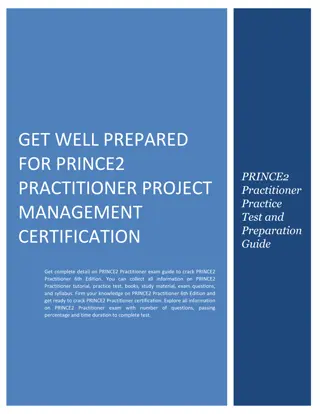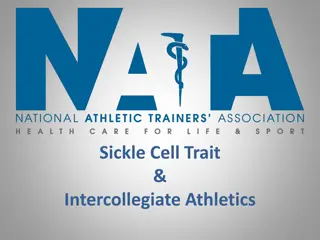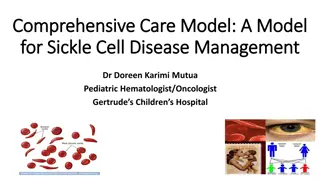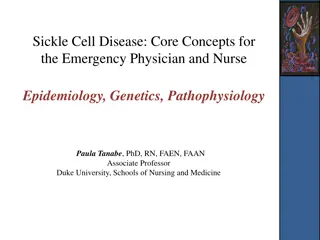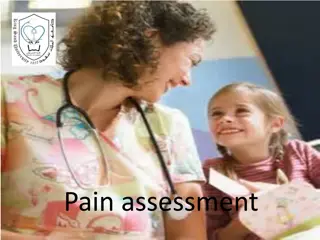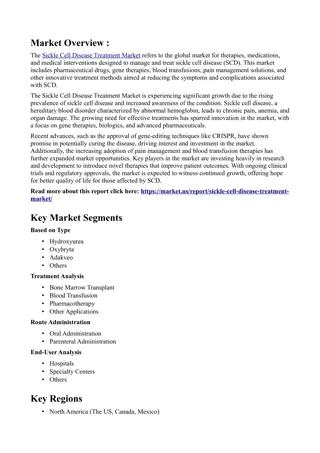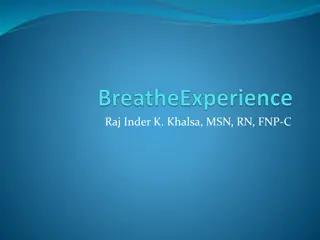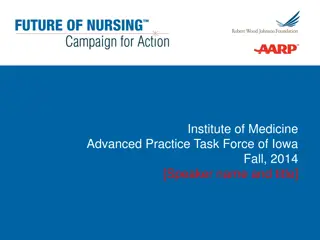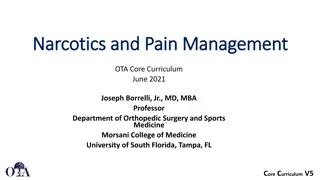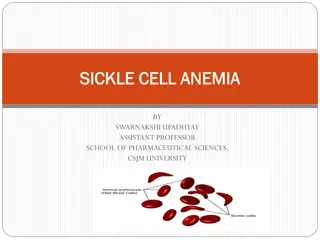Impact of Nurse Practitioner-Led Pain Management on Sickle Cell Disease Outcomes in African American Adults
"Exploring the effects of individualized pain management plans led by nurse practitioners on length of stay, 30-day readmission rates, and quality of care for African American adults with sickle cell disease. The study aims to assess the potential benefits of this approach in improving healthcare outcomes for this population."
Download Presentation

Please find below an Image/Link to download the presentation.
The content on the website is provided AS IS for your information and personal use only. It may not be sold, licensed, or shared on other websites without obtaining consent from the author.If you encounter any issues during the download, it is possible that the publisher has removed the file from their server.
You are allowed to download the files provided on this website for personal or commercial use, subject to the condition that they are used lawfully. All files are the property of their respective owners.
The content on the website is provided AS IS for your information and personal use only. It may not be sold, licensed, or shared on other websites without obtaining consent from the author.
E N D
Presentation Transcript
An Examination of a Nurse Practitioner-Led Individualized Pain Plan Management Upon Length of Stay, Hospital 30- Day Readmission Rate, and Quality of Care for African American Adults with Sickle Cell Disease Karen Macey-Stewart, DNP, AGPCNP-C,RN-C Faculty Advisor: Dr. Kem Louie Faculty Team Member: Dr. Naa-Solo Tettey Expert: Karen Kiefer, MSN, APN-C, NP-C, RN-BC Department of Nursing Doctor of Nursing Practice Program
Chapter 1:Background Sickle Cell Disease (SCD): Africa, South America, Central America, India & Mediterranean countries. 1 per 500 births are African American (AA) Mortality/Life Expectancy 2005: Median survival for AA age 38-42 2013: Median survival for AA age 58-67 By age 50 for AA: irreversible damage to one or more organ systems Financial Impact on Healthcare Total Lifetime Healthcare cost: $1 million for individual with SCD by age 45 Hospital visit: from $30,000 for adult with each hospitalization
Chapter 1: Background Pain: Primary reason to seek medical care at an acute care facility Barriers Healthcare Team Perception & Knowledge Deficit Frequent utilization of the acute care setting Lack of primary care Lack hematologist Funding ($0.04 Billion) Cystic Fibrosis: 1/3 the population & receive 3.5x more funding Cancer & Heart Disease: $1.2- $5.4 billion respectively
Chapter 1: Background Gap Lack of evidence-based research due to nonexistent National or State database The effectiveness and outcomes of patients cared for by NPs in the acute care setting QI: Using an IPMP for AA adults with SCD in the acute care setting Patient s lived experience with pain in the acute care setting
Chapter 1: Background Quantitative Research Question What is the effectiveness of an Individualized Pain Management Plan (IPMP) led by a nurse practitioner and a Traditional Pain Management Plan (TPMP) on patients length of stay (LOS), hospital 30-day readmission rate and quality of care for African American adults with Sickle Cell Disease (SCD)? Qualitative Research Question What is the lived experience of an individual with Sickle Cell Disease?
Chapter 1: Background Hypothesis The IPMP will decrease the LOS for African American (AA) with SCD The IPMP will decrease the 30-day readmission rate The IPMP will improve the quality of care for AA by examining the quality indictors: Timing of medication administration Effectiveness of medication administration The use of nonopioid analgesia in providing pain relief Nonpharmacological interventions- heat packs, spiritual consults, integrative medicine Qualitative Research Question What is the lived experience of an individual with Sickle Cell Disease?
Chapter 1:Background Ten Qualitative Questions for The Interview 1. Do you experience pain every day? If yes, can you describe your pain (chronic pain) for me? 2. Can you describe the severe pain (acute) that prompts you to come to the hospital or that you attempt to manage at home? 3. When the pain intensifies at home what, do you do to alleviate the acute pain (nonpharmacological or pharmacological)? 4. Do you have triggers that can prompt acute pain such as infection, time of year, stress, etc. for example? If yes, what are some of those triggers? 5. On average, what time of the year do you usually have severe pain that you need to seek pain relief at a hospital?
Chapter 1: Background Ten Qualitative Questions for The Interview (continued) 6. Do you always come to the hospital when you have severe pain (acute pain) at home? If no, why don t you come to the hospital when the pain is severe and acute? 7. What are some of the coping strategies that you use while in the emergency room awaiting care for your severe pain? 8. What are some of the nonpharmacological interventions that you do while you are hospitalized to decrease some of the pain? 9. Does using the 0-10 pain scale adequately represent your acute pain? If no, what type of pain scale would you create or recommend that would be more appropriate for your pain assessment by the healthcare team? Or recommend that would be more appropriate for your disease? 10. What would you want the healthcare team to know when treating your acute pain both in the emergency room and on the unit where you receive care as an inpatient?
Chapter 2 Theoretical Framework Katharine Kolcaba: The Comfort Theory (Kolcaba & Fisher, 1996) RELIEF EASE TRANSCENDECE PHYSICAL Insomnia & Pain Administration of parental opioids Ability to sleep although pain is not well controlled PYSCHOSPIRITUAL Depression Anxiety Support from family, friends and healthcare team Feeling calm & less depressed and anxious with support from others ENVIROMENTAL Noisy Unit Bright Lights Uncomfortable Dimmed Lights Closed room door Personal Items from home Improve sleep hygiene Enhance comfort SOCIOCULTURAL Lack of home routine when in pain Inability to work Hot Showers Heating Packs Massage Prayer Computer Access Feels more at home and in control
Chapter 2: Review of Literature Andemarian & Jones (2016): Retrospective chart review- 5 years pre and post Adult SCD clinic at UConn Health Effectiveness of treatment of patients with SCD in a clinic setting with NP-Led Outpatient Clinic Population growth, Preventative visits, Admission rates, LOS, & Hospital readmission rates Used an algorithm for the management of acute SCD from NHLBI with the following results: Decrease hospital admission from 50% to 30% Decrease LOS from 12 days to 6 days on average 30-day hospital readmission rate decrease from 60%-40%
Chapter 2: Review of Literature Molokie et al., (2018): Comparative retrospective study Examine the effects of usual care for adults with SCD in the ACU vs. ED with a focus on the opioid doses, discharge pain rating, hospital admission rates, & LOS Usual care- ED: lower doses of opioids; ACU: hematologist & patient discussion Results: Pain on discharge: ED (6/10) & ACU (4/10) Admissions: ED (70%) vs. ACU (37%) LOS same for both. Mean average ED (8.8) vs ACU (5.3) Opioid administration: ED 67% morphine, 28% hydromorphone, 5% no opioids; ACU 74% morphine, 26% hydromorphone, 0% no opioids Utilization of guidelines for a higher dose of opioids in an acute care setting were associated with less pain & decreased hospital admissions.
Chapter 3: Methods Research Design: Mixed Method Comparative Descriptive Study Sample Power Analysis: 60 but actual sample size is 61 individuals with SCD Quantitative Analysis: Twelve participants admitted for painful crisis due to SCD were interviewed on day three of their hospital admission Inclusion: 18-70 years old; AA or African descent; Various Dx SCD; Methadone dependency, opioid dependency, thrombocytopenia, anemia, chronic pain; DVT; VOC, ACS, variety of infections Exclusion: <18 years old; prisoners, pregnant women, direct admission to the inpatient unit and cognitively impaired individuals Method Two of the five suburban hospitals within one healthcare system in New Jersey Emergency Department (ED) All hospital units that individuals with SCD are located as an inpatient
Chapter 4: Results Descriptive Statistics Treatment Years TPMP 2014-2016 IPMP 2017-2019 Sample Size 61 61 Female 60.7% 62.3% Male 39.3% 37.7% Mean age 29.64 32.00 AA or AA descent 96.7% 96.7%
Chapter 4: Results Length of Stay (LOS) TPMP 7.89 days IPMP 5.66 days Independent Sample t test p= .024 Mean difference = 2.2230 days
CHAPTER 4: RESULTS 30-Day Hospital Readmission Rate Pearson Chi-Square Test p=.054
CHAPTER 4: RESULTS QI: Timing of medication administration TPMP: M= 83.28 vs. IPMP: M= 67.51 minutes first dose QI: Medication Administration Chi-Square Test p=.002
CHAPTER 4: RESULTS Pain reassessment and Utilization of The IPMP Pain Reassessment after 1st Dose Pearson Chi-Square Test p=.015
CHAPTER 4: RESULTS Pain reassessment and Utilization of The IPMP Pain Reassessment after 2st Dose Pearson Chi-Square Test p=.007
CHAPTER 4: RESULTS Pain reassessment and Utilization of The IPMP QI: Pain Reassessment after 3st Dose Pearson Chi-Square Test p=.001
CHAPTER 4: RESULTS Hematologist involved in Care in the Community Pearson Chi-Square Test p= .000
CHAPTER 4: RESULTS Nonpharmacological Interventions Pearson Chi-Square Test p=.000
CHAPTER 4: RESULTS Qualitive Study Central Themes Communication with the healthcare team Advocacy of the nursing staff Identifying triggers that precipitate a painful crisis Effective pain management when in the acute care setting Self-care pain management at home and in the hospital Lack of trust in the judgment of the patients' perception of the healthcare team Stigma and bias as obstacles to obtaining adequate pain relief
CHAPTER 4: RESULTS 50% report pain every day 58% Musculoskeletal pain & 48% severe bone pain It feels like someone is using a sledgehammer on my bones. Someone crushing my bones & someone stabbing into the bones with a sharp object. 92% used alternatives to opioids in the acute care setting 75% heat therapy, sleeping, and hydration 25% cell phone Triggers for painful crisis: Stress 75% Weather 67%: 83% winter, 58% summer, 17 % spring, & 25% fall Infections & Menstrual periods 17% Employment 8%
CHAPTER 4: RESULTS 75% will not go to the hospital with an acute painful crisis I try to manage it at home. My brother died from a botched EGD at the age of 22 years old, and he went in for sickle cell pain. I don t trust healthcare people that don t look like me. No. I don t want to be labelled or put into a box and be labeled a drug seeker. I would rather stay at home. The labeling is the worse part because I m not drug seeking. ED coping mechanisms when in severe crisis: 100% Cell phone; 42% Mediation I go to my special place in my mind that I created at six years old where there are no bad memories, Netflix, and Pandora. Sometimes I think people have it worse than me.
Chapter 4 Results Numerical Pain Scale: 83% did not represent their pain One participant created her own scale that is outlined below: 0=No Pain 1= a little pain 2= pain that can be handled using complementary things- heat therapy, etc. 3= pain that can be controlled by taking Tylenol or ibuprofen 4= pain that does not affects your everyday movement 5= pain that does affect your everyday movement 6= Pain that can be controlled only with prescribed pain medicine 7= Pain that is severe enough that it cannot be controlled by your prescribed opioids alone 8= When the pain is intense, all you can do is sleep, and when you wake up, you can t communicate how bad the pain is. 9 and 10= you cannot do anything at all, communicate, walk, eat, or talk but just sleep
CHAPTER 4 RESULTS Message to the ED healthcare team The pain is real; it is not like a simple broken bone pain. We are not the same, please don t generalize us. Please use the individualized pain plan. Educate yourself about sickle cell disease and the complications that can kill us. We are not drug addicts. Remember, cancer patients can become drug addicts. I m not faking the pain. At least hear the patient out about what meds work for me and where my IV should be placed.
CHAPTER 4 RESULTS Message to the unit staff and inpatient healthcare team Communicate with respect; healthcare is supposed to be a democracy. Listen to us about what we need (I m the expert of my disease. Don t treat me like an experiment. ) Advocate for me when I can t do it for myself. Don t be afraid to give me more pain medication because you are not comfortable that won t help me. ( When I say we are itching, we really are itching, and that s not a game. ) I want to get to a point where I don t have to take any pain medications. SCD gets in the way of life.
Implications to Nursing and DNP Essentials Clinical Prevention and Population Health Utilization of the National Guidelines as the standard of care Adult Sickle Cell Clinics across the country Health Care Policy Changes: National Database Increase in Federal funding for research studies, pharmaceutical cost, and educational initiatives Increase opportunity for DNPs in the acute care setting Interprofessional Collaboration Patient-centered care approach in the acute care setting Education on opioid requirements Transition from pediatric sickle cell clinic to an adult sickle cell clinic
References Andemarian, B. & Jones, S. (2016). Development of a New Sickle Cell Disease Center Within an Academic Cancer Center: Impact on Hospital Utilization Patterns and Care Quality. Journal of Racial and Ethnic Health Disparities. 3:176-182 American Society of Hematology. State of Sickle Cell Disease. (2016). Retrieved from http://www.scdcoalition.org/pdfs/ASH%20State%20of%20Sickle%20Cell%20Disease%202016%20 Report.pdf American Society of Hematology. (2016). AHS foundation. Retrieved from http://www.hematology.org/Foundation/6836.aspx American Society of Hematology. (2017). Sickle Cell Disease. Retrieved from http://www.hematology.org/Patients/Anemia/Sickle-Cell.aspx Brodsky, M.A., Rodeghier, M., Sanger, M., Byrd, J., McClain, B., Covert, B., Roberts, D.O., Wilkerson, K., DeBaun, M.R. & Kassim, A.A. (2017). Risk factors for 30-day readmission in adults with sickle cell disease. The American Journal of Medicine.130, 600.e09-601.e15. Center for Disease Control and Prevention. (2017). What is Sickle Cell Disease? Retrieved on October 27, 2018, from https://www.cdc.gov/ncbddd/sicklecell/facts.html Hamideh, D. & Alvarez, O. (2013). Sickle cell disease-related mortality in the United States (1999 2009). Pediatric Blood and Cancer. 60(9). 1482-1486. https://doi.org/10.1002/pbc.24557 Kolcaba, K. & Fisher, E. (1996). A holistic perspective on comfort care as an advance directive. Critical Care Nursing Quarterly. 18(4), 66-76.
REFERENCES Kolcaba, K. (2001). Evolution of the mid-range theory of comfort for outcomes research. Nursing Outlook, 49(2), 86 92. Kolcaba, K. (2007). Applying comfort theory to your patient population. Retrieved from http://www.thecomfortline.com/home/faq.html#comfort%20-%20definition Lanzkron, S., Carroll, C. P., & Haywood, C., Jr. (2013). Mortality rates and age at death from sickle cell disease: U.S., 1979-2005. Public Health Reports, (2), 110. Retrieved from https://ezproxy.wpunj.edu/login?url=http://search.ebscohost.com/login.aspx?direct=true&db=edsghw& AN=edsgcl.323688038&site=eds-live&scope=site Molokie, R., Montminy, C., Dionisio, C., Farooqui, M.A., Gowhari, M., Yao, Y., Suarez, M.L., Ezenwa, M.O., Schlaeger, J.M., Wang, J. Z., & Wilkie, D. (2018). Opioid doses and acute care utilization outcomes for adults with sickle cell disease: ED versus acute care unit. American Journal of Emergency Medicine. 36. 88-92. National Heart, Lung and Blood Institute. (2014). Evidence-Based management of sickle cell disease. Retrieved from https://www.nhlbi.nih.gov/health-topics/evidence-based-management-sickle-cell-disease Piel, F.B., Steinberg, M.H., & Rees, D.C. (2017). Sickle cell disease. The New England Journal of Medicine. 1561-1573. United Nations Population Division (2010) World population prospects, the 2010 revision. New York: United Nations Population Division. Retrieved from http://esa.un.org/unpd/wpp/index.htm. World Health Organization fifty-ninth world health assembly. (2006). Sickle cell anemia. Retrieved from http://apps.who.int/gb/archive/pdf_files/wha59/a59_9-en.pdf
